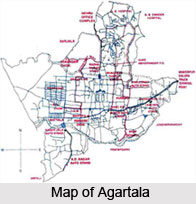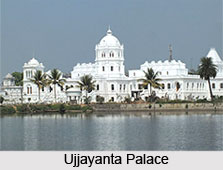 Agartala is the capital of Indian state Tripura. Agartala is denoted as the second largest capital city in North east India. Agartala is rich in flora and fauna. The legendary state of Tripura is a fascinating world in itself. Agartala gained prominence when Maharaja Krishna Manikya shifted his capital here in the 19th century.
Agartala is the capital of Indian state Tripura. Agartala is denoted as the second largest capital city in North east India. Agartala is rich in flora and fauna. The legendary state of Tripura is a fascinating world in itself. Agartala gained prominence when Maharaja Krishna Manikya shifted his capital here in the 19th century.
Location of Agartala
The administrative centre is very reminiscent of the low-level towns of Bangladesh, whose border is just 2 km away. It is situated on the banks of Haroa River. Agartala is located at about 1680 km from Kolkata (Calcutta) and 599 km from Guwahati, Assam.
History of Agartala
History of Agartala began from the mythological era. One of the earliest kings of Agartala was Patardan1900 BC. It was the time long before the Manikya Dynasties. Chitrarath, Drikpati, Dharmapha, Loknath Jivandharan were the important king during the time of ancient history of India in Agartala. Later, Agartala served as the Princely State "Swadhin Tripura". In 1760, Agartala was shifted by the Maharaja Krishna Chandra Manikya Bahadur of Manikya Dynasty to present old Agartala by the bank of the river Saidra River and was named `Haveli`.
Geography of Agartala
Agartala is situated in a plain along the Haora River, though the city also extends to the low lying hills on its northern parts.

Demography of Agartala
According to the Population Census in the year 2001, the total literates in Agartala city are 343,633 of which 174,524 are males while 169,109 are females. The average literacy rate of Agartala city is 93.88 percent of which male and female literacy was 95.75 and 92.02 percent respectively. The sex ratio of Agartala city is 1002 per 1000 males. The child sex ratio of girls is 940 per 1000 boys.
Tourism in Agartala
Agartala has places that are famous for rock cuts and carvings like Debtamura situated at 75km away from Agartala and Unakoti located at about 178 km from Agartala and Pilak about 100 km from Agartala. Some of the important tourist destinations like Ujjayanta Palace, Kunjaban Palace, Neermahal, Mata Tripureshwari Temple, Neermahal, Mata Tripureshwari Temple, Jannath temple and Jampui Hills.
Visiting Information
The best time to visit Agartala is between October and April. The town is known for its cultural and historical worth that is visible when one sees the bright bamboo and cloth umbrellas over ponds. Such parasols are part of the tribal customs of grandsons commemorating the deaths of their grandfathers on their anniversaries. Agartala is connected by airlines flights with Kolkata (Calcutta), Guwahati, and Delhi. The two nearest railway stations are Kumarghat (160 kms) and Dharama Nagar (200 kms), Silchar- 288 kms, Guwahati- 599 kms, Shillong- 499 kms, Dharmanagar- 200 kms.



















